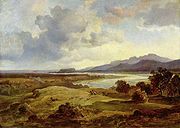
Carl Rottmann
Encyclopedia

Munich
Munich The city's motto is "" . Before 2006, it was "Weltstadt mit Herz" . Its native name, , is derived from the Old High German Munichen, meaning "by the monks' place". The city's name derives from the monks of the Benedictine order who founded the city; hence the monk depicted on the city's coat...
) was a German
Germany
Germany , officially the Federal Republic of Germany , is a federal parliamentary republic in Europe. The country consists of 16 states while the capital and largest city is Berlin. Germany covers an area of 357,021 km2 and has a largely temperate seasonal climate...
landscape painter and the most famous member of the Rottmann family of painters.
Rottmann belonged to the circle of artists around the Ludwig I of Bavaria
Ludwig I of Bavaria
Ludwig I was a German king of Bavaria from 1825 until the 1848 revolutions in the German states.-Crown prince:...
, who commissioned large landscape
Landscape art
Landscape art is a term that covers the depiction of natural scenery such as mountains, valleys, trees, rivers, and forests, and especially art where the main subject is a wide view, with its elements arranged into a coherent composition. In other works landscape backgrounds for figures can still...
paintings exclusively from him. He is best known for mythical and heroising landscapes. The landscape painter Karl Lindemann-Frommel belonged to his school.
Biography
Rottmann was born in Handschuhsheim (today a part of HeidelbergHeidelberg
-Early history:Between 600,000 and 200,000 years ago, "Heidelberg Man" died at nearby Mauer. His jaw bone was discovered in 1907; with scientific dating, his remains were determined to be the earliest evidence of human life in Europe. In the 5th century BC, a Celtic fortress of refuge and place of...
) on January 11, 1797. There he received his first drawing lessons from his father, Friedrich Rottmann, who taught drawing at the university in Heidelberg. He formed himself chiefly through the study of nature and of great masterworks. In his first artistic period, he painted atmospheric phenomena. After gaining prominence with Heidelberg at Sunset (a water color), and Castle Eltz, he settled in Munich in 1822 and devoted himself to Bavarian scenery. Here his second period began, and in 1824 he married Friedericke, the daughter of his uncle, Friedrich Ludwig von Sckell
Friedrich Ludwig von Sckell
Friedrich Ludwig von Sckell was a German landscape gardener from Weilburg an der Lahn.Sckell was trained in the Court Market Garden in Schwetzingen near Mannheim and worked after his apprenticeship in Bruchsal, Paris, and Versailles. From 1773 to 1777, he was in England busying himself with...
, who served as an attendant at court.
Through this connection, he made the acquaintance of King Ludwig I of Bavaria
Ludwig I of Bavaria
Ludwig I was a German king of Bavaria from 1825 until the 1848 revolutions in the German states.-Crown prince:...
, who in 1826/27 sponsored his travels in Italy in order to widen his repertoire, which up to that point consisted solely of domestic, German, landscapes. In Italy, Rottmann made sketches for the 28 Italian landscapes in fresco
Fresco
Fresco is any of several related mural painting types, executed on plaster on walls or ceilings. The word fresco comes from the Greek word affresca which derives from the Latin word for "fresh". Frescoes first developed in the ancient world and continued to be popular through the Renaissance...
which he was commissioned to paint in the arcades of the Hofgarten at Munich. The cycle, completed in 1833, gave visual expression to Ludwig’s alliance with Italy, and raised the genre of landscape painting to the height of history painting, the preferred mode of the King’s other great commissions for monumental painting. The frescos unfortunately deteriorated under climatic influences. The cartoons for them are in the Darmstadt Gallery.
In 1834 Rottmann traveled to Greece
Greece
Greece , officially the Hellenic Republic , and historically Hellas or the Republic of Greece in English, is a country in southeastern Europe....
to prepare for a commission from Ludwig for a second cycle; one might mark here the beginning of his third period. At first also intended for the Hofgarten arcade, the 23 great landscapes were eventually installed in the newly-built Neue Pinakothek
Neue Pinakothek
The Neue Pinakothek is an art museum in Munich, Germany. Its focus is European Art of the 18th and 19th century and is one of the most important museums of art of the nineteenth century in the world...
where they were given their own hall.
Of his easel pictures, Ammer Lake and Marathon are in the National Gallery, Berlin; The Acropolis of Sikyon and Corfu in the Pinakothek, Munich; others in the Schack Gallery, Munich, and in Karlsruhe; and seven in the Leipzig Museum.
Carl Rottmann died on July 7, 1850 in Munich, aged 53 of undisclosed causes. He is buried in the Alter Südfriedhof
Alter Südfriedhof
The Alter Südfriedhof is a cemetery in Munich, Germany. It was founded by Duke Albrecht V as a plague cemetery in 1563 about half a kilometer south of the Sendlinger Gate between Thalkirchner and Pestalozzistraße.-History:...
in Munich.
Works
- Frescoes with heroising landscapes in the arcade of the Munich Hofgarten (1830–33) (today in the Munich Residenz Museum).
- 23 Greek landscapes (1838–50, today in the Neue Pinakothek, although a number were substantially destroyed during World War II) in the ancient technique of encaustic.

